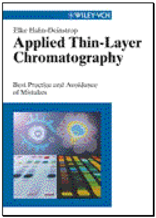![Molecules 05 00983 i001]()
Thin layer chromatography (TLC) is a powerful, fast and inexpensive analytical method. It has proven its usefulness in pharmaceutical, food and environmental analysis. With this new book both new comers and experienced practitioners can make full use of these advantages of TLC.All steps of the analytical procedure are clearly explained, starting with the choice of a suitable TLC technique and ending with data evaluation and documentation. Special emphasis is put on the proper choice of materials for TLC. Properties and functions of various materials and the TLC equipment are described, covering e. g. precoated layers, solvents and developing chambers, and including information on suppliers. Many practical hints for trouble shooting are given. All this is illustrated with numerous coloured figures.How to use TLC in compliance with GLP/GMP regulations is described in detail, including the required documentation. Therefore the reader can very easily compile his own standard operating procedures.
Below is the Table of Contents:
1 Introduction (What is TLC?/ When is TLC used?/ Where is TLC used/ How is the result of a TLC represented?/ What kinds of reference substances are used in TLC?/ The literature on TLC); 2 Precoated layers (Why use precoated layers?/ How are precoated layers produced?/ What kinds of precoated layers are there?/ What are precoated layers used for?/ Criteria for choosing stationary phases in TLC/ Effect of the stationary phase when the solvents are identical/ Recommendations for the pro-curement and storage of precoated layers/ Problems in the nomenclature and classification of precoated layers); 3 Before TLC development (Handling of the precoated layers/ Prewashing/ Activation/ Conditioning/ Impregnation/ Application of the sample/ Positioning of the sample/ Drying before development); 4 Solvent, developing chambers and development (Solvent/ TLC developing chambers/ Development of thin-layer chromatograms/ Drying after development); 5 Evaluation without derivatization (Visual direct evaluation/ Optical direct evaluation using special equipment/ Coupling methods for substance identification/ Documentation without or before derivatization); 6 Derivatization (Thermochemical reaction/ Irradiation with high energy light/ Reaction with reagents/ Special types of derivatization/ Treatment of derivatized chromatograms); 7 Evaluation after derivatization (Visual evaluation/ Evaluation by TLC scanner/ Evaluation by video system/ Evaluation by flat-bed scanner); 8 Documentation (Description of a thin-layer chromatogram/ Documentation by reproduction, tracing or photocopying/ Photographic documentation/ Video documentation/ TLC scanner documentation/ Flatbed scanner documentation); 9 GMP/ GLP-conforming TLC work (Validation of TLC methods/ Use of qualified/ calibrated equipment/ GMP/ GLP-conforming rawdata sheets/ Examples of GMP/ GLP-conforming testing procedures); 10 Loading effects (Definite loading of a substance/ TLC of sensitive substances); 11 Special methods in TLC (AMD - Automated Multiple Development/ OPLC - Overpressured Layer Chromatography/ HPPLC - High Pressure Planar Liquid Chromatography/ TLC-FID/ FTID - Combination of TLC with Flame Ionization Detector or Flame Thermoionic Ionization Detector/ RPC - Rotation Planar Chromatography); 12 Appendix (Chromatography and art/ References/ Abbreviations used/ Acknowledgements/ Market review).
*
Editor's Note: The brief summary and the contents of the books are reported as provided by the author or the publishers. Authors and publishers are encouraged to send review copies of their recent books of potential interest to readers of
Molecules to the Editor-in-Chief (Dr. Shu-Kun Lin, MDPI, Saengergasse 25, CH-4054 Basel, Switzerland. Tel. +41 79 322 3379, Fax +41 61 302 8918, E-mail:
molinfo@mdpi.org). Some books will be offered to the scholarly community for the purpose of preparing full-length reviews.




